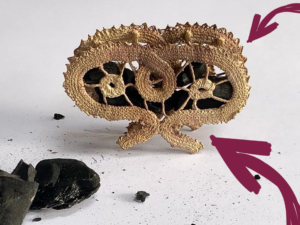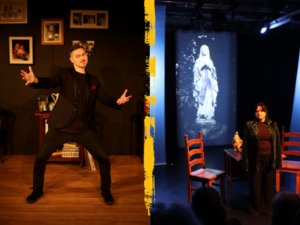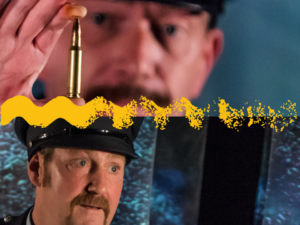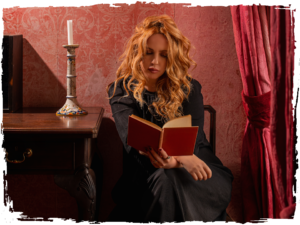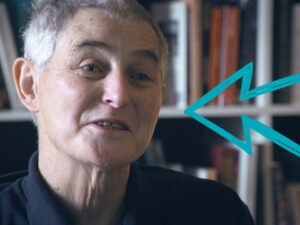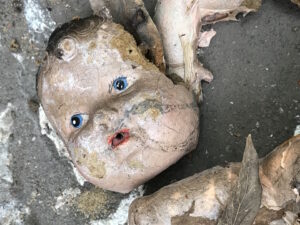
5-years!
Festivals get the opportunity to work with all sorts of people, often from all sorts of places. This work allows us to introduce artists to one another and foster long-term relationship. We watch careers develop and see people’s stars rise. When we met Carrie Barrett in Limerick, 5-years ago, she was just stepping in to her ascent; recognising her voice and putting it to work. In 2022, we had her shadow our Director across the Festival. We aimed for Carrie to meet as many ‘Liverpool’ people as possible; see the inner-workings of our operation and test her toes in Mersey-waters. Here, Carrie reflects on the time she’s spent with us and what she left remembering.
Article contents
I first attended the Liverpool Irish Festival in 2018, performing works I’d written for the In:Visible Women segment of the Festival. During my brief time there, I attended as many of the Festival events that I could squeeze i
Sights and sounds: Part one
A particular highlight, for me, was a gathering of the Liverpool Irish community who shared their experiences and those of their descendants. Each story was different in description, but the experience was shared. Themes of displacement, loss, poverty, exclusion and shame echoed through. Although the pain was palpable. the feeling in the room was one of understanding, connection and catharsis. I felt humbled and honoured to witness these stories and spend time with our now aging ex-pats, whose heart and souls played a pivotal role in the diverse cultural community that is Liverpool today.
Part two
Four years later, I returned to Liverpool as resident artist for the Festival. The resonance of the stories I heard -of those who fled to foreign shores, not knowing what future lay in store for them- from the 1930s right through to the eighties (when I was born) was very much alive in me. As such, stepping foot on Liverpool soil felt like stepping through a portal. A portal that takes you to a place and space in time that feels like Ireland wearing the weight of the cloaked emigrant experience.
Influence
The Irish influence is very much imbedded in Liverpool culture. The streets are filled with Irish bars; traditional Irish music echoes onto the streets. Irish accents and turns of phrases are not unusual to hear. Our influence and contribution extend to the city’s architecture, thanks to the likes of Robert Cain’s investment in the ‘most ornate’ Philharmonic Dining Rooms and the physical authority of The Metropolitan Cathedral, often known ‘Paddy’s Wigwam’. The Irish influence and presence are tangible.
Hunger
2022’s Festival theme of ‘hunger’ delved deep into the Liverpool Irish experience. Conversations and events explored how the Irish Famine changed the face of Liverpool forever, when 1.2m people crossed the sea in hope of refuge. Images of women, men and children collapsing on the Royal Albert Dock of Liverpool, dying of starvation, typhus and cholera -like an apocalyptic scene- flooded my mind.
The sheer terror of lay Liverpudlians -helplessly witnessing their home being overrun by this ‘Irish infestation’- must have felt hopeless. Hapless victims of their monarch’s actions and without help from their ministry, the Scouse did what they could to help the victims of coercive genocide. Housing them in makeshift basement slums, opening soup kitchens and burying the dead in paupers’ graves was all necessary.
Britain’s chickens had come home to roost. It was the irreproachable citizens that were to bear the brunt of the burden. Amid these horror scenes, wonderful stories emerged of people who stepped up to help the city deal with this plague and create legacies in the city, notables such as Dr Duncan Father Nugent and others.
Movers and shakers
I spoke with a local playwright John Maguire, who wrote a play about one such heroine called Kitty Wilkinson. She was an immigrant, from Derry, now revered as the ‘Saint of the Slums’ and ‘Queen of the Washhouse’. In 1778, as just a young girl, she sailed to Liverpool with her family. They lost her father and baby sister during the crossing due to a storm at sea, breaking her mother’s heart. At age 11, Kitty went to work in a cotton mill.
In 1832 she took it upon herself to help the sick and dying, making made porridge to feed starving children. Kitty gave up her home to the sick. Vitally, she shared her boiler -the only one in the community- with her neighbours. Not only this, she would disinfect their clothes and sheets in chloride and lime, staving off the cholera epidemic. Successfully campaigning for a public bath and wash house (opened 1842), Kitty’s work with homeless children and sanitation is honourable. John’s play Kitty Wilkinson: Queen of the Washhouse toured earlier this year.
Characters beyond the Famine
I attended the Festival’s Irish Famine Trail’s Revive: a Research Relay event. Presented by the Trail’s History Research Group, they revealed the stories they’d found linked to the Trail’s sites. Here, I learned of characters such as ‘Dandy Pat’. Born in Wexford (1854), he was so named for his stylish outfits and white hat and is recognised for his involvement in the development of working-class provisions. Agnes Jones -who lived through the Great Hunger- became the first nurse superintendent of the Brownlow Hill Workhouse (1865), a role which would reform workhouses and welfare across Victorian institutions.
I was surprised to hear the stark history of the Irish and Scouse experience, juxtaposed with the kindness and altruism of the local and Irish heroines and heroes. Several of these stand -cast in bronzed brilliance- for all of Liverpool to see. These stories and experiences imprinted on me a grà (love) and respect for the people of Liverpool.
Community resilience
It’s evident the Liverpool Irish community is thriving and continuing to affect the culture of their own diaspora, as well as Liverpool as a whole. This is thanks to projects such as the Liverpool Irish Festival, the Liverpool Irish Centre, The Mersey Mash podcast and local artists such as John Maguire (ArtsGroupie CIC).
Their dedication and implementation of progressive conversations and expressive works is imperative for the understating and evolution of ‘Irishness’. This is as important in Liverpool as in all diaspora communities. Despite best efforts and the time that has passed, the resonance of intergenerational trauma is still tangible. The sense of loss and longing (for a home that’s becoming an abstract esoteric sentiment rather than ‘a place’) reverberated through the Festival. It was there in story, song, poetry and people. While I experienced this, I felt more connected to -and appreciative of- my Irishness than I ever have at ‘home.’
As homage to the Liverpool Irish diaspora, I have written the following piece:
Home
Isolation in a nation of millions
Incessant longing for belonging
To find the missing peace
feel at ease, sink into the seat of her soul
become part of the whole
A magnetic pull craving to be full,
from her bounty, drink in her smell
hear her ancestors tell their story
shame and glory, eradication of kin
run and hide a piece of her deep inside
passed to child
imprinted on his soul
Raging waves crash against her shore
shout no more,
go within her cave of truth and listen
feed again from land once barren,
feast on the salt of the earth
seasoned by the tears of forefathers and mothers
her fertile soil awaits your return
Carrie Barrett, 4 Nov 2022
Carrie is a facilitator, dramatist and playwright from Limerick, ROI. You can see more about her on the National Academy of Dramatic Art site: https://www.thelir.ie/students/carrie-barrett

